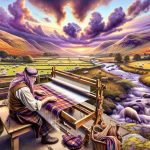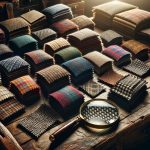I've always thought of tweed as more than just a fabric; it's a statement of class and history. Born in Scotland, tweed is deeply woven with traditions and craftsmanship that scream luxury. Whether it's the intricate herringbone patterns or the robust feel, there's something undeniably upscale about it. Major fashion icons and designers have draped their models in tweed, proving its lasting appeal. But here's the kicker: does its rich heritage and high-profile usage really make tweed luxurious, or is there more to the story? Let's unpack this and see where the threads lead us.
Table of Contents
Key Takeaways
- Tweed is synonymous with artisanal craftsmanship, reflecting a rich heritage and skilled production methods.
- High-end fashion brands and designers frequently incorporate tweed, enhancing its luxury status.
- The fabric's unique textures and patterns, like Herringbone and tartan, contribute to its sophisticated appeal.
- Tweed's durability and timeless style make it a long-term, high-value investment in fashion.
- Celebrity endorsements and appearances in luxury fashion contexts elevate tweed's perception as a premium material.
Origins of Tweed
Tweed originated in Scotland in the 18th century as a durable fabric for farmers. Initially, it was a practical choice, designed to withstand harsh weather and rough working conditions. But there's more to tweed than its rugged beginnings. Delving into tweed folklore, each pattern and color variation tells a unique story, often linked to the specific region where it was created. These regional variations aren't just about aesthetics; they're a historical record of local resources and dyeing techniques that were available at the time.
Over the years, tweed has woven its way into the fabric of Scottish culture, quite literally. The material was typically made using local wool, and the natural dyes available influenced the hues and patterns specific to an area. For instance, the mossy greens and earthy browns were derived from local plants and minerals, reflecting the landscape from which they were sourced. This deep connection between the fabric and its place of origin adds a layer of richness to the tweed narrative.
Today, while tweed is celebrated worldwide for its sophistication and style, understanding its roots enhances its luxury. Knowing that each thread carries a tale of regional heritage and artisanal craftsmanship makes wearing tweed a profoundly personal experience.
Tweed Production Process
Understanding the historical significance of tweed only enhances the appreciation for how it's made today. The production process of tweed is a fascinating blend of tradition and skill, particularly when you explore material sourcing and weaving techniques. I'm always amazed by the meticulous care that goes into selecting the raw materials. Wool is the primary component, often sourced from local sheep, ensuring that the fabric retains its authentic, rustic charm.
Material sourcing is more than just gathering wool; it involves a keen understanding of how different breeds impact the texture and quality of the finished tweed. From the soft undercoat of Shetland sheep to the denser fleece of the Cheviots, each contributes uniquely to the final weave.
Speaking of weaving, the techniques used in tweed production are as crucial as the materials themselves. Handweaving on treadle-powered looms is still practiced, preserving a link to the past. However, modern techniques have also been adopted to maintain efficiency without sacrificing quality. The interplay of warp and weft yarns, carefully aligned by skilled weavers, creates the distinctive, resilient fabric that tweed is known for.
This intricate process, combining artful material sourcing with precise weaving techniques, truly sets tweed apart as a luxurious material.
Iconic Tweed Patterns
Delving into the world of tweed, it's hard not to be captivated by its iconic patterns, each with a story to tell. These patterns aren't just about aesthetics; they're a tribute to pattern innovation and the mastery of weaving.
One of the most recognized patterns is the herringbone, named for its resemblance to the skeleton of a herring fish. It's a zigzagging pattern that adds depth and texture to the fabric, making it visually engaging and sophisticated.
Another standout is the check pattern, which includes the well-loved tartan. With its crisscrossing horizontal and vertical bands in multiple colors, tartan is more than just fabric; it's a symbol steeped in history and clan identity. The versatility and color diversity in these patterns allow for a range of expressions, from subtle earth tones to vibrant, eye-catching hues.
Windowpane is another classic pattern, characterized by thin lines forming large, clear squares resembling window panes. It's simpler yet bold and is perfect for those who prefer a minimalist yet striking design.
Each pattern in tweed fabric tells a unique story, rich in tradition and innovation, making tweed not just luxurious but culturally significant.
Tweed in Fashion History
Fashion's timeline has been greatly shaped by the enduring appeal of tweed, marking it as a staple from vintage eras to modern-day trends. Historically, tweed's journey in fashion is characterized by its rugged charm and practicality. Originating from Scotland and Ireland, it was initially the fabric of choice for outdoor pursuits among the aristocracy. This was largely due to tweed's durability, which allowed wearers to brave harsh climates without sacrificing comfort or style.
As I dig deeper, it's clear that tweed's path wasn't just about staying warm. By the 20th century, tweed had sewn its place into urban fashion too. Designers began experimenting with tweed, integrating tweed innovations into their collections, thus transforming the fabric from purely functional to a symbol of sophistication and style. It was no longer just for the countryside; tweed became a fixture in high fashion, worn by icons and influencers.
This evolution wasn't just about aesthetics but also about adapting to the changing demands of fashion enthusiasts. Tweed's texture, ability to dye in various hues, and weaving patterns diversified its appeal and functionality, ensuring that it remained relevant in the ever-evolving fashion landscape.
Modern Tweed Creations
Today's designers are reimagining tweed in innovative ways that blend tradition with cutting-edge style. They're not just sticking to the classic jackets and coats; they're pushing boundaries and incorporating tweed into modern wardrobes with a fresh twist. From sleek tweed trainers to chic handbags, the versatility of tweed is being explored like never before.
One of the most exciting tweed innovations I've seen involves integrating smart technology into the fabric itself, transforming ordinary tweed into a dynamic, functional material suitable for the tech-savvy fashionista. Imagine a tweed jacket that adjusts its temperature based on the weather or a tweed bag that can charge your smartphone!
Here's a quick look at some of the cool, modern takes on tweed:
| Tweed Item | Modern Twist |
|---|---|
| Tweed Sneakers | Ultra-lightweight with memory foam soles |
| Tweed Smart Jacket | Embedded with climate control technology |
| Tweed Backpack | Solar panels for device charging |
| Tweed Accessories (Belts) | Integrated with LED lighting |
These aren't your grandparents' tweed items. Designers are crafting tweed accessories that appeal to both tech enthusiasts and fashion purists, ensuring that tweed remains as relevant today as it was a century ago.
Celebrities Wearing Tweed
Celebrities are embracing tweed, making it a staple on red carpets and casual outings alike. It's fascinating to see how this traditional fabric has become synonymous with sophistication and style in the celebrity world. When you spot A-listers sporting tweed at major events, it's evident that this material isn't just about heritage; it's a modern fashion statement. These appearances play a significant role in setting red carpet trends, showing us that tweed can be both glamorous and edgy.
The influence of celebrity endorsements on tweed's popularity can't be overstated. Stars like Emma Watson and Ryan Gosling have been seen wearing tweed, thus broadening its appeal. They aren't just wearing it; they're transforming it, combining it with contemporary styles that make headlines and set trends. This not only keeps tweed relevant but also cements its status as a luxurious material in the public eye.
As these icons display tweed's versatility, from formal suits to chic, casual blazers, they inspire fashion enthusiasts and designers to innovate further. Each celebrity outing in tweed captures media attention, reinforcing its desirability and luxury, important for anyone trying to master an understanding of current fashion dynamics.
Tweed on the Global Stage
Building on its celebrity endorsements, tweed has also made a significant mark on international fashion scenes. It's fascinating to see how this fabric has woven its way into various cultures, adapting while maintaining its quintessential Scottish identity. As I've explored fashion capitals, it's clear that tweed isn't just about heritage; it's about global appeal.
International tweed now features in collections from Paris to Tokyo, each designer adding a unique twist while respecting its roots. The fabric's texture and versatility make it a favorite for both high-end fashion and everyday streetwear. It's not just about the look; the functionality of tweed, especially in colder climates, makes it a practical choice as well.
However, the journey of tweed on the global stage isn't without its challenges. Tweed tariffs have occasionally impacted its accessibility and price outside the UK. Countries imposing higher tariffs can see a significant price increase, which affects how common tweed is in those markets. Despite this, the demand continues, driven by both its luxury status and its durability.
I've seen firsthand how international tweed has captivated audiences worldwide. Its journey from Scottish moors to metropolitan runways is a reflection of its enduring appeal and adaptability.
Comparing Tweed With Other Fabrics
When comparing tweed with other fabrics, its unique texture and durability really stand out. Tweed's tightly woven fibers offer a robustness that's hard to beat, making it a top choice for outerwear that lasts. It's fascinating to see how it holds up against more common materials like cotton or synthetic blends.
Cotton, while softer and lighter, doesn't provide the same level of insulation or protection against the elements. Synthetics might come close in durability, but they often lack the breathable comfort and classic aesthetic that tweed brings to the table.
In terms of cost comparison, tweed can initially seem pricier than some alternatives. However, considering the longevity and timeless style it offers, I find it's worth the investment. It's not just about buying a piece of clothing; it's about investing in a garment that holds its value and appeal over time. Plus, tweed's resilience means less frequent replacements, which can actually make it more cost-effective in the long run.
Caring for Tweed Garments
Caring for your tweed garments properly can significantly prolong their lifespan and preserve their unique style.
First off, let's talk about keeping them clean. It's best to brush your tweed regularly with a soft clothes brush; this keeps the fabric neat and prevents dirt from settling. For stains, a quick spot clean with a damp cloth usually does the trick. Avoid tossing tweed into the washing machine — it prefers a gentle dry cleaning to maintain its shape and texture.
Now, onto tweed waterproofing. If you're planning to wear your tweed in wet weather, consider applying a waterproofing spray specifically designed for wool. This will help to repel water without damaging the fibers or altering the appearance of your garment. Always test on a small, inconspicuous area first!
When it comes to tweed repairs, be proactive. Check for any signs of wear or damage such as loose threads or small holes. These can often be mended at home with some basic sewing skills, or by a professional if it's beyond your comfort zone. Regular maintenance not only keeps your tweed looking great but also prevents minor issues from becoming major ones.
Taking these steps guarantees your tweed remains as timeless and luxurious as ever.
Future Trends in Tweed
Looking forward, tweed is set to embrace innovative designs that blend tradition with modern fashion trends. As I explore further into what's next for this timeless fabric, it's clear that the future of tweed hinges on two pivotal aspects: tweed technology and tweed sustainability.
We're already seeing incredible advancements in tweed technology that are transforming how this fabric is produced and worn. Imagine tweed that's not only durable but also incredibly lightweight and adaptable to various climates. This isn't just a possibility; it's on the horizon thanks to new weaving techniques and fiber treatments that enhance functionality without compromising the classic aesthetic.
Moreover, tweed sustainability is becoming a non-negotiable aspect of its production. The focus is now on eco-friendly practices that minimize environmental impact. This means using organic wool, promoting ethical sheep farming, and adopting natural dyes that reduce harmful runoff. It's all about making tweed a guilt-free luxury.
These innovations in technology and sustainability are shaping a new chapter for tweed, one that respects its rich history while boldly stepping into the future. I'm excited to see how these changes won't only preserve but elevate tweed's status in the luxury fashion world.
Frequently Asked Questions
Can Tweed Be Dyed Into Any Color?
Yes, tweed can be dyed any color, but it's tricky due to color retention challenges and the intricacies of the dyeing process. You've got to really know your stuff to get it right.
Is Tweed Suitable for Summer Wear?
I don't think tweed's ideal for summer wear. It lacks breathability, making it too hot. However, its styling options are versatile, fitting well into varied looks if you can handle the warmth.
Does Tweed Cause Allergies or Skin Irritation?
I've found that tweed can be a bit rough on sensitive skin, potentially triggering fabric sensitivities and allergies. It's worth checking if you're allergic to any materials commonly used in tweed production.
Are There Vegan Alternatives to Traditional Tweed?
Yes, there are vegan alternatives to traditional tweed, featuring sustainable sourcing and fabric innovation. I've found these options to be quite effective for maintaining that classic look without using animal products.
How Does Tweed Impact the Environment?
Tweed production's environmental footprint is significant, as it often involves high water and chemical use. I'm exploring sustainable practices to reduce these impacts and make tweed a more eco-friendly fabric choice.
- Is Tweed More Expensive Than Wool? - April 24, 2024
- Is Tweed Fabric Itchy? - April 24, 2024
- How Durable Is Tweed? - April 24, 2024








